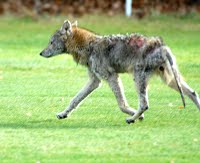ADULT COYOTE(S)

Do not underestimate an injured adult.
1. OBSERVE
What is normal behavior?
It is not unusual to see a coyote out during the day. Coyotes will venture out during daylight hours since that is when their main prey are active. Coyotes are opportunistic feeders. If a coyote is seen outside during the day, the animal is most likely in pursuit of a squirrel, rabbit, or other daytime food source.
Non-Releasable Animals
Animals not releasable back into the wild must seek sanctuary from a center that can adequately care for them. Respect should always be given, but trust is earned – do not blindly trust anyone, human or non-human.
3. CALL
Something is wrong.
If an injured, sick or abnormally behaving coyote is seen, contact an animal control operator for assistance. Signs such as unprovoked aggression, impaired movement, paralysis or lack of coordination, uncharacteristic tameness, disorientation, or self-mutilation (paw chewing) can indicate rabies or other neurologic diseases/problems. Keep all people and pets away from the animal in distress and monitor from a safe distance until help arrives. Veterinarians and rehabilitators licensed to handle foxes have had the rabies vaccine.
The signs of rabies are obvious in this video example, but can you tell this is not a victim of a car-strike? Always exercise caution and stay in your vehicle to observe.
Does the coyote’s coat look patchy?
If a young or adult coyote is seen with partial or complete hair loss, this usually indicates sarcoptic mange, caused by a microscopic mite that moves around in the skin. Animals with mange lose hair and weight; they become debilitated, their skin becomes cracked and encrusted with heavy scabs and they usually die within a few months as a result.

Treatment without capture:
Some rehabilitators report success treating mange in the field by giving the afflicted animal a piece of hot dog or chicken with a small pea-sized dab of Ivermectin (such as Strongid horse wormer) in it, administered every five days for three rounds. Note that this is considered an “off-label” usage of this product. It is vital to ensure that the medicated bait gets given to the target animal. Medicated food should never be left out, because the wrong animal could get it, and over-dosing is a real risk. Rather, a site can be pre-baited at the same time each day, so the target animal appears with regularity and can be thrown the bait.
